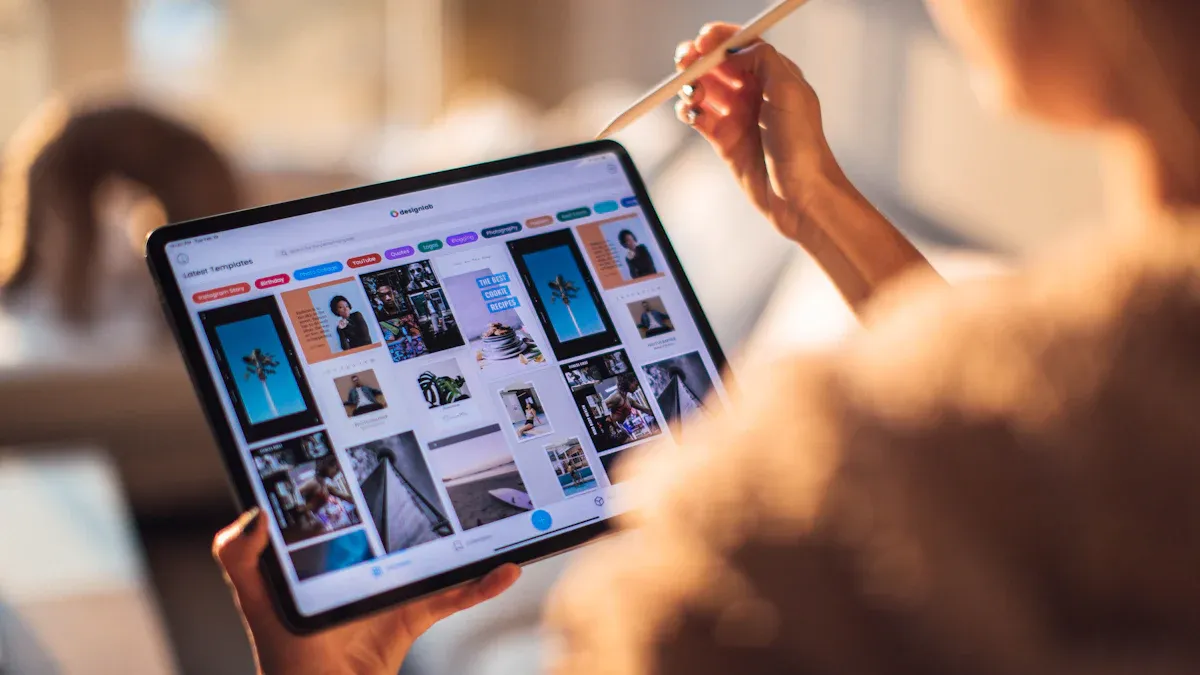Healthcare video marketing is changing how you reach patients in 2025. Videos make hard medical ideas simple and easy to understand. Types like explainer videos and patient stories help people feel connected and build trust. By focusing on patient needs, videos create a patient-first approach that boosts interest. More people want videos, with 89% asking for more from brands. A good content plan keeps healthcare services seen and trusted online, meeting the needs of today’s smart patients.
Benefits of Healthcare Video Marketing
Helping patients learn with healthcare video content
Healthcare videos make hard medical ideas simple to understand. They show treatments, procedures, or conditions in a clear way. This helps patients feel informed and confident about their care. For example, an animated video on diabetes can explain how to check blood sugar step by step.
Studies say videos grab attention better than text or pictures. Patients remember more when they watch videos, helping them make smart health choices. Research shows that patients who understand their health are more likely to take action, leading to better results.
Tip: Use videos to guide patients from diagnosis to recovery. Make sure they feel supported all the way.
Gaining trust with real stories
Real stories in healthcare videos build trust by showing patient experiences. When patients see stories they relate to, they feel closer to the provider. For example, a video about a patient’s recovery after surgery can give hope to others in similar situations.
The Mayo Clinic’s “Sharing Mayo Clinic” blog is a good example of this. They share real patient stories to show they care and build trust. Stories also turn hard medical facts into easy-to-follow messages, making healthcare more interesting.
Note: Be real. Share true stories that show your care for patients.
Boosting patient interest and loyalty
Videos are great for keeping patients interested. They grab attention fast and keep people watching. Live Q&A videos or explainers can get patients to ask questions and learn more.
Patient stories and reviews also help build loyalty. A video of a happy patient sharing their experience can comfort others and keep them coming back. Use data like watch times to improve your videos and match what patients want.
Tip: Check how patients interact with your videos. Change your content to fit their needs.
Supporting staff training and internal communication
Videos are not just for patients. They also help train staff and improve communication. In healthcare, keeping your team skilled is very important. Videos make learning easier and more interesting.
Training videos teach staff new skills or procedures quickly. Instead of reading long guides, they can watch clear demonstrations. For example, a video on using a new device saves time and prevents mistakes. Staff can pause or rewatch until they feel ready.
Tip: Make short videos for specific tasks. This keeps attention and helps learning.
Videos also improve internal communication. Sharing updates or changes through videos makes messages clear and personal. A video from leaders can lift spirits and show employees they matter. For instance, a CEO’s video about goals can inspire more than an email.
Here are ways to use videos for staff training and communication:
-
Onboarding new employees: Show your organization’s values with fun videos.
-
Demonstrating best practices: Use real examples to teach patient care standards.
-
Sharing success stories: Celebrate team wins to encourage teamwork.
Note: Use analytics to see how staff uses training videos. This helps improve content and fix knowledge gaps.
Videos make learning and communication simple for your team. This leads to better work, happier staff, and improved patient care.
Key Video Marketing Trends in Healthcare for 2025

Personalized healthcare video content for patient-centric care
Personalized videos are changing healthcare marketing by focusing on patients. These videos make you feel important and understood. They help build a stronger bond with healthcare providers. For example, a video about your treatment plan based on your health history can explain tough ideas simply. This method matches patient-focused care, where your health journey is the main focus.
Healthcare video marketing now uses data to make videos just for you. By studying what you like and do, providers create videos that solve your problems. This not only grabs your attention but also builds trust. When videos match your needs, you are more likely to act and stay loyal to the provider.
Tip: Use personalized videos to help patients through their health journey, from start to finish.
Live streaming to foster real-time patient interaction
Live streaming is a big trend in healthcare video marketing. It lets you talk to healthcare experts live, making medical info easy to get. Webinars and live Q&A sessions let you ask questions and get answers fast. This builds trust and brings people together.
This method also helps with online checkups and remote surgeries. You can get expert care at home, saving time and effort. For example, live streaming can show how to care for yourself after surgery, cutting down on extra doctor visits. It shows providers care by talking to you directly and solving your worries.
Did you know? Live streaming helps patients connect with healthcare providers easily during medical events.
AI-driven video marketing trends for efficiency and relevance
AI is making healthcare video marketing faster and smarter. AI tools study data to make videos that fit your likes, keeping them useful and fun. For instance, AI can create videos in many languages, so more people can understand healthcare info.
AI also makes hard medical topics easier to learn. Videos made with AI can explain treatments or conditions clearly. This helps patients learn and feel connected. AI also tracks how you watch videos, helping providers improve their plans for better results.
| Benefit | Description |
|---|---|
| Better Learning | AI videos make medical info simple and clear. |
| More Engagement | AI videos build emotional bonds and boost action rates. |
| Wider Access | Multilingual videos help more people get healthcare info. |
Note: AI tools make video marketing easier, helping providers give you the right content quickly.
360-degree video tours for immersive patient experiences
360-degree videos change how patients see healthcare places. These videos let you look around hospital rooms, waiting areas, and even operating rooms from home. Virtual tours help you feel ready and less nervous about visits or treatments.
Some hospitals in England already use this idea. Four hospital groups now offer 360-degree tours to help patients know their surroundings. This works well in cancer care, where treatments can be long and stressful. These videos give you control and ease fears about the unknown.
Tip: Show your clean spaces, modern tools, and patient-friendly areas with 360-degree videos. This builds trust in your care.
Multilingual video content to connect with diverse audiences
Healthcare videos should meet the needs of all patients. Multilingual videos help people who don’t speak English understand important health info. Seeing videos in your language makes hard medical ideas easier to follow and helps you feel closer to your provider.
| Key Point | Description |
|---|---|
| Accessibility | Multilingual videos make health info easy for everyone to access. |
| Trust Building | They build trust by meeting language needs. |
| Patient Engagement | They make health info relatable and engaging. |
For example, videos explaining treatments or sharing patient stories in different languages make healthcare simpler. They also build trust and show that you matter.
-
They create trust with diverse groups.
-
They make health info easy to relate to.
Did you know? Multilingual videos are a great way to connect with patients from different cultures.
Omnichannel strategies for seamless healthcare video marketing
Omnichannel strategies help healthcare videos reach you everywhere. Providers share videos on social media, email, and websites to give the same message on all platforms. This makes it simple for you to find health info anytime, anywhere.
A study says 96% of people watch videos to learn about services. In healthcare, personal video messages have boosted patient interest by 53%. For instance, a Los Angeles agency saw a 20% rise in bookings after using patient story videos.
Tip: Share videos on platforms your audience likes. This ensures your message reaches the right people at the right time.
By using 360-degree tours, multilingual videos, and omnichannel strategies, healthcare providers can make a better experience for patients. These trends are shaping healthcare video marketing in 2025.
Actionable Strategies for Healthcare Providers
Hosting interactive webinars and live Q&A sessions
Interactive webinars and live Q&A sessions help connect with patients. These formats let you answer questions right away. Using tools like polls and live chats makes sessions fun and helpful. For example, a webinar about chronic conditions can include a poll. This helps understand patient worries and adjust the talk.
But, many healthcare webinars lack enough interaction. Studies show fewer questions are asked now, down by 30%. Chat activity is also 40% lower than in other fields. To fix this, add more ways for patients to join in. Ask them to share stories or ask questions. This builds trust and makes your audience feel closer to you.
Tip: Use live Q&A sessions to solve patient worries and show your knowledge.
Leveraging user-generated content for authenticity
User-generated content (UGC) makes healthcare marketing feel real. Videos of patients sharing their stories connect with viewers. These videos show the caring side of healthcare, making it relatable. For instance, a video of a patient’s recovery can inspire others in similar situations.
UGC also boosts social media activity. When patients post their stories on Instagram or Facebook, it spreads your message further. Create campaigns asking patients to share their health journeys. Featuring these stories shows you care and value their experiences.
Note: Always get permission before using patient stories in your videos.
Prioritizing high-quality healthcare video content production
Good healthcare videos grab attention and show professionalism. Invest in good tools, skilled creators, and clear scripts. A well-made video about a medical procedure can help patients understand and trust your care.
Track key performance indicators (KPIs) to see how your videos perform. Metrics like views, watch time, and engagement show what works. For example, high engagement means people like and interact with your content.
| Video KPI | What It Measures | Why It Matters |
|---|---|---|
| View Count | Times a video is watched | Shows how many people it reaches |
| Watch Time | Total time spent watching | Shows how interested viewers are |
| Engagement Rate | Likes, shares, and comments | Shows how much viewers interact |
| Click-Through Rate | Viewers clicking on links | Shows if viewers take action |
| Conversion Rate | Viewers completing desired actions | Shows how effective the video is |
Focus on quality and check KPIs often. This helps improve your videos and meet patient needs.
Tip: Check your video KPIs regularly to make better content for patients.
Partnering with influencers and patient advocates
Working with influencers and patient advocates can improve your healthcare videos. Influencers in health and wellness already have loyal followers. Teaming up with them helps you reach more people quickly. For example, a fitness influencer could share a video about your hospital’s therapy services. This makes your services relatable to their audience.
Patient advocates are also important. They share personal stories and connect with others facing similar struggles. A video of a patient advocate talking about their recovery can inspire hope. It can also encourage others to seek care. These partnerships make your videos feel real and show you care about patients.
Pick influencers and advocates who share your organization’s values. Give them clear instructions but let them tell their stories their way. This keeps your message consistent while feeling honest and personal.
Tip: Look for influencers and advocates on social media who match your audience.
Using analytics to refine video marketing strategies
Analytics help improve your healthcare video strategies. They show what works and what doesn’t. By checking engagement, you can see which videos grab attention. For example, if a video about post-surgery care has high views, it’s popular with viewers.
Use analytics to make future videos better. Data shows trends like the best times to post or topics people like most. You can also see how videos affect actions like booking appointments. This helps you focus on what brings real results.
-
How analytics help video marketing:
-
Find out which videos work best.
-
Change plans based on what the data shows.
-
See how videos lead to actions like scheduling visits.
-
Note: Check your analytics often to keep up with patient needs.
Using analytics helps you make videos that connect with your audience and get results.
Examples of Successful Healthcare Video Marketing Campaigns

Image Source: unsplash
Case study: Live streaming for patient education
Live streaming has changed how patients learn about health. It lets you get real-time advice from medical experts. Complicated topics become easier to understand this way. For example, a hospital might host a live Q&A about diabetes care. You can ask questions and get answers right away. This makes learning more fun and interactive.
Live streaming also helps ease fears about treatments. Watching a live surgery or procedure can make you feel ready and calm. Providers using live streaming show they care about being open and helpful. It builds trust and makes you feel closer to your doctor.
Tip: Join live streaming events from your doctor to stay updated.
Example: Personalized video campaigns for chronic care management
Personalized videos work well for managing long-term health issues. These videos focus on your needs, making care feel personal. A healthcare group in New York used patient data to create special videos. They checked feedback and improved their plans. In one year, they kept 30% more patients and raised satisfaction by 45%.
These videos guide you step by step through your care. For example, a video about your treatment plan can help you follow it better. Personalized videos teach and build trust at the same time.
Did you know? Custom videos can make your healthcare journey much better.
Highlight: Multilingual video strategies for global outreach
Multilingual videos help patients from different cultures understand health info. They are great for people who don’t speak English well. Watching videos in your language makes treatments easier to follow. It also helps you feel closer to your doctor.
These videos reduce gaps in healthcare access. They make it easier for everyone to get the care they need. Providers using multilingual videos show they care about all patients.
Tip: Pick doctors who offer videos in many languages for better communication.
Healthcare video marketing in 2025 changes how you reach patients. Trends like personalized videos, live streaming, and multilingual content make care better. These ideas help patients stay interested, trust providers, and understand health info. For example, personalized videos boost interest by 53%, and video stories increase bookings by 20%.
Using new video ideas helps patients get better care. Videos explain hard medical topics in simple ways. They also build stronger connections between patients and providers. By following these trends, you can improve care, make patients happier, and stay ahead in healthcare.
Tip: Use these video strategies now to help your patients more.


